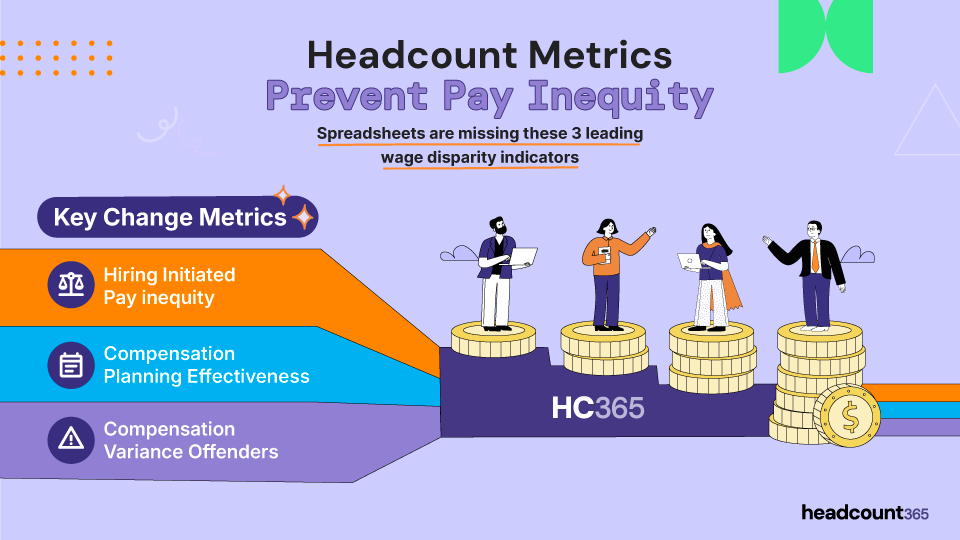Preventing Pay Inequity With Headcount Data
Table of Contents
Pay inequality rarely stems from bad intent—it’s often a byproduct of using compensation as a tool to solve other business problems.
Origins of Pay Inequity
Hiring pressure, offer negotiations, backfills, internal transfers—these are operational realities. And when the compensation becomes the lever to fix them, you create an unintended variance. The role of a compensation and leveling framework is to prevent that. But frameworks alone can’t keep up with the forces constantly reshaping your org.
Global markets shift. Equity valuations rise and fall. New geos open. Managers lobby for talent. And priorities change fast. Even the most well-designed framework can break under the weight of business demands. That’s why variance tracking is the key to preventing pay inequality—not just reporting it after the fact.
Variance Tracking Stops Pay Inequity Before it Starts
At its core, variance is anytime actual compensation deviates from what was intended in your framework. It can be structural, strategic, or subtle—but it’s always trackable if you know where to look.
Common Variance: Net New Headcount
Offers come in above or below the target band
Levels change late in the process, but the title stays the same
Attrition Budgets shift when replacing a departing employee
Approved headcount moves between departments or managers
Common Variance: Existing Employees
Tenure “grandfathers” employees into outdated pay
Promotions that leapfrog levels or skip review cycles
New titles or levels created outside the formal structure
These deviations aren’t inherently bad. Sometimes they’re necessary. But left untracked, they become systemic. That’s when pay gaps form—and persist.
Timing + Persona = Context for Pay Inequity
When the variance happens and which role triggered it are critical for HR teams who look to prevent or correct this behavior. For Example:
Finance & compensation making changes to a new hire’s budgeted salary prior to the recruiting process has different implications than recruiters and hiring managers changing compensation during the offer negotiation to close a candidate.
HRBPs changing compensation bands during a headcount planning cycle are more predictable than hiring managers creating one-off changes during promotions or offers.
Budget Owners changing compensation and/or job leveling during a promotion cycle are more predictable than changes initiated during a backfill process.
Timing + persona gives you the root cause. It shows you where the process breaks down—and where to build in controls.
Reactive Compensation Variance Tracking is Obsolete
Today, HR leaders review HRIS data to understand compensation variance that’s already happened. This reactive approach, means HR teams are reacting to variance vs preventing it before it starts.
I created Headcount365 after trying to solve this problem on spreadsheets for years. We’re here to help solve pay inequity, initiated by adding new headcount or making changes to existing employees.
Preventative Pay Inequity Tools
Compensation Approval Workflows: Customize compensation approvals based on what changes AND who requests them.
Requisition Tagging: Requisitions or Employee IDs that fall outside of compensation & leveling frameworks are automatically tagged with the information for reporting.
Headcount Activity Feed: All headcount have a history of activity, so that the context of how they ended up in their current financial position can always be tracked.
Inter-System Tracking in One Dataset: An employee story does not start in the HRIS. The role started on an annual headcount plan and navigated the recruiting & job offer process. Having the entire employee story on one record helps companies better understand the origins of pay inequity.
Pay Inequity Risk Reporting: Every time a job creates HR Risk, it’s flagged in customizable reporting to help HR teams change behavior before it gets out of hand.
The New Standard for Pay Equity
Variance tracking isn’t an add-on—it’s foundational. Preventing pay inequality doesn’t require perfection. It requires visibility.
Your frameworks should set the standard. But your systems should show you where that standard is bending—and when it’s about to break.
Headcount365’s automated variance tracking gives you the tools to intervene early, enforce consistency, and protect equity across the employee lifecycle.

